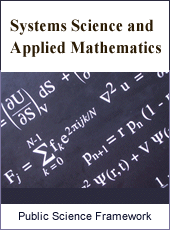Systems Science and Applied Mathematics
Articles Information
Systems Science and Applied Mathematics, Vol.1, No.2, Oct. 2016, Pub. Date: Sep. 23, 2016
Mathematical Model of the Social Dissatisfaction Level for Research of Social and Economic System of Denmark
Pages: 23-28 Views: 4363 Downloads: 992
[01]
Nadezhda A. Zhuravleva, Department of Economic Informatics, Ufa State Aviation Technical University (USATU), Ufa, Russia.
[02]
Michel Yu. Dolomatov, Department of Economic Informatics, Ufa State Aviation Technical University (USATU), Ufa, Russia; Department of Oil and Gas Engineering, Ufa State Petroleum Technological University (USPTU), Ufa, Russia.
[03]
Vitalij V. Martynov, Department of Economic Informatics, Ufa State Aviation Technical University (USATU), Ufa, Russia.
[04]
Elena Sh. Zakieva, Department of Economic Informatics, Ufa State Aviation Technical University (USATU), Ufa, Russia.
[05]
Victor I. Rycov, Department of Economic Informatics, Ufa State Aviation Technical University (USATU), Ufa, Russia.
[06]
Natalja V. Dzinter, Department of Economic Informatics, Ufa State Aviation Technical University (USATU), Ufa, Russia.
[07]
Stepan I. Ermilov, Department of Economic Informatics, Ufa State Aviation Technical University (USATU), Ufa, Russia.
The article is devoted to the creation of tools for the assessment of the level of social dissatisfaction. The model of the assessment is carried out on the base of one factor (the index of social dissatisfaction based on income differentiation). The scope of application of the results of this study is to support decision-making by planning of the socio-economic development. Evaluation of methodological tools was carried out on the example of the Denmark, which showed the dynamics in the levels of social-economic dissatisfaction (2000 – 2014). Social dissatisfaction in Denmark was absent in this period.
Mathematical Model, Assessment of the Levels of Social Dissatisfaction, Income Distribution
[01]
Pirogov, I. V. (2002). Social unsatisfaction: Theory, methodology and measurement methods: Dis. PhD social sciences. Moscow, 177.
[02]
Esteban, J. & Ray, D. (1994). On the Measurement of Polarization. Econo-metrica, vol. 62 (4), 819–851.
[03]
Esteban, J. & Ray, D. (1999). Conflict and Distribution. Journal of Economic Theory, vol. 87 (2), 379–415.
[04]
Zhang, X. & Kanbur R. (2001). What Difference Do Polarisation Measures Make? An Application to China. The Journal of Development Studies, 37 (3), 85-98. doi: 10.1080/00220380412331321981.
[05]
Biancotti, C. (2006). A polarization of inequality? The distribution of national Gini coefficients 1970–1996. Journal of Economic Inequality: Springer, 4, 1–32.
[06]
Woo, J. (2006). Fiscal Deficit, Fiscal Volatility and Growth: Social Polarization. The Political Economy of Fiscal Policy. Lecture Notes in Economics and Mathematical Systems. Springer, vol. 570, 7-33. doi: 10.1007/3-540-31417-2_2.
[07]
Woo, J. (2006). Inflation, Composition of Deficit Finance, and Social Polarization. The Political Economy of Fiscal Policy. Lecture Notes in Economics and Mathematical Systems. Springer, vol. 570. 35-45. doi: 10.1007/3-540-31417-2_3.
[08]
Esteban, J. & Gradyn, C. & Ray D. (2007). An Exunsatisfaction of a Measure of Polarization, with an application to the income distribution of five OECD countries. J Econ Inequal, Springer, vol. 5, 1–19. doi: 10.1007/s10888-006-9032-x.
[09]
Esteban, J. & Schneider, G. (2008). Polarization and Conflict: Theoretical and Empirical Issues. Journal of Peace Research, vol. 45, 131-141. doi: 10.1177/0022343307087168.
[10]
Esteban, J. & Ray, D. (2011). Comparing Polarization Measures. Oxford Handbook of the Economics of Peace and Conflict, Oxford University Press. Retrieved from http://www.nyu.edu/econ/user/debraj/Papers/EstRayChapter.pdf.
[11]
Esteban, J. & Ray D. (2011). Linking Conflict to Inequality and Polarization. American Economic Review, American Economic Association, vol. 101 (4), 1345-1374.
[12]
Esteban, J. & Mayoral, L. & Ray D. (2012). Ethnicity and Conflict: An Empirical Study. American Economic Review, American Economic Association, vol. 102 (4), 1310-1342.
[13]
Permanyer, I. (2012). The conceptualization and measurement of social polarization. The Journal of Economic Inequality. Springer US, vol. 10, issue 1, 45-74.
[14]
Fusco, A. & Silber, J. (2014). On social polarization and ordinal variables: the case of self-assessed health. Eur J Health Econ. Springer-Verlag Berlin Heidelberg, vol. 15 (8), 841-851. doi: 10.1007/s10198-013-0529-5.
[15]
Sonin, K. (2011). Sonin.ru: Economy lessons. Moscow: United Press. 255.
[16]
Montalvo, J. G. & Reynal-Querol, M. (2010). Ethnic Polarization and the Duration of Civil Wars, Economics of Governance, vol. 11 (2). 123-143.
[17]
Dolomatov, M. Yu. (2005). Fragments of the theory of real substance. From hydrocarbonic systems to galaxies. Moskow: Chemistry. 208.
[18]
Dolomatov, M. Yu. & Zhuravliova, N. A. (2013). Information system of an social dissatisfaction assessment. Certificate of computer program registration No. 2013661801.
[19]
Dolomatov, M. Yu. & Martynov, V. V. & Zhuravleva, N. A. & Filosova, E. I. & Zakieva, E. Sh. (2015). Information system of an assessment of social dissatisfaction level based on equilibrium thermodynamics laws. Труды СПИИРАН, vol. 4 (41). Retrieved from http://proceedings.spiiras.nw.ru/ojs/index.php/sp/article/view/3152/1816/pdf.
[20]
Yanovsky, R. G. (1999). Global changes and social safety. Moscow: Academia, 44.

ISSN Print: Pending
ISSN Online: Pending
Current Issue:
Vol. 2, Issue 2, April Submit a Manuscript Join Editorial Board Join Reviewer Team
ISSN Online: Pending
Current Issue:
Vol. 2, Issue 2, April Submit a Manuscript Join Editorial Board Join Reviewer Team
| About This Journal |
| All Issues |
| Open Access |
| Indexing |
| Payment Information |
| Author Guidelines |
| Review Process |
| Publication Ethics |
| Editorial Board |
| Peer Reviewers |


